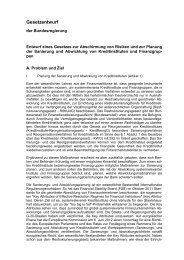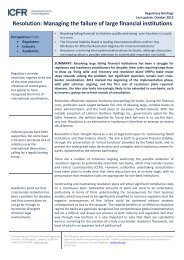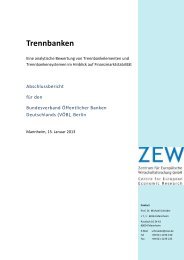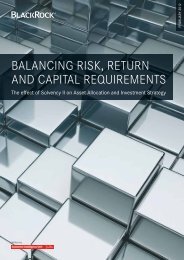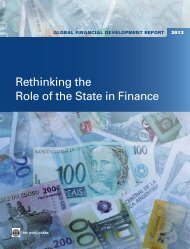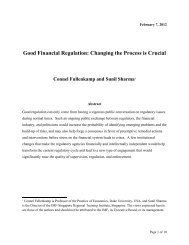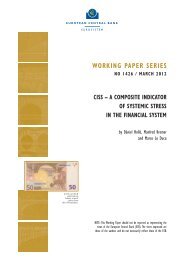3 Issuing costs of state guaranteed bonds - Financial Risk and ...
3 Issuing costs of state guaranteed bonds - Financial Risk and ...
3 Issuing costs of state guaranteed bonds - Financial Risk and ...
You also want an ePaper? Increase the reach of your titles
YUMPU automatically turns print PDFs into web optimized ePapers that Google loves.
4 Impact <strong>of</strong> <strong>state</strong> <strong>guaranteed</strong> <strong>bonds</strong> on bank lending, funding <strong>and</strong> pr<strong>of</strong>itability performance<br />
Tt is a vector <strong>of</strong> time dummies<br />
Tt*i is a vector <strong>of</strong> country-time interaction effects<br />
vi is a bank-specific error term<br />
it is an idiosyncratic error term<br />
Time <strong>and</strong> country effects account for unobserved heterogeneity at the country level <strong>and</strong> across<br />
time that may be correlated with <strong>state</strong> guarantees. Time <strong>and</strong> country interaction effects are used<br />
to capture time-varying country effects that may be correlated with <strong>state</strong> guarantees. And, due to<br />
the presence <strong>of</strong> heteroscedasticity <strong>and</strong> autocorrelation (indicated by diagnostic tests) <strong>and</strong> the<br />
possibility <strong>of</strong> contemporaneous correlation, a fixed effects model with Driscoll-Kraay st<strong>and</strong>ard<br />
errors that are robust to the abovementioned forms <strong>of</strong> dependence is used.<br />
Impacts<br />
Table 25 (columns 1 <strong>and</strong> 2) show the results <strong>of</strong> the main leverage model. All coefficients are<br />
statistically significant at less than the 1% level aside from pr<strong>of</strong>its. Banks’ leverage depends<br />
positively on size, <strong>and</strong> negatively on the ratio <strong>of</strong> total earning assets to total assets <strong>and</strong> dividends.<br />
The models also explain variation in the data relatively well, with an adjusted R 2 <strong>of</strong> 0.4.<br />
We observe participation in <strong>state</strong> guarantee schemes (i.e., GUARANTEEDit=1 as opposed to<br />
GUARANTEEDit=0) is associated with lower leverage. Specifically, banks that issued <strong>bonds</strong> with<br />
<strong>state</strong> guarantees are likely to be 0.2% less levered than comparable banks that did not issue <strong>state</strong><br />
<strong>guaranteed</strong> <strong>bonds</strong>.<br />
Moreover, banks that utilised <strong>state</strong> guarantees more intensively, i.e., through the issuance <strong>of</strong> a<br />
larger volume <strong>of</strong> <strong>state</strong> guarantees, were even less levered. A proportionate increase in <strong>state</strong><br />
<strong>guaranteed</strong> <strong>bonds</strong> relative to total equity <strong>and</strong> liabilities <strong>of</strong> 1% was associated with a 3.4% decrease<br />
in market leverage. This effect was significant beyond the 99% level.<br />
Overall, banks that take up <strong>state</strong> guarantees are likely to be less levered. Under the regulated<br />
capital view, it may be that participation in <strong>state</strong> guarantee schemes were implicitly conditional on<br />
banks being more cautious, as reflected in levels <strong>of</strong> market leverage.<br />
Under the capital buffers view, these banks may have signalled to the market that they are "ailing<br />
banks" through participation in <strong>state</strong> guarantee schemes, in the terminology used above.<br />
Therefore, they face higher <strong>costs</strong> <strong>of</strong> capital than other banks <strong>and</strong> hold larger capital buffers to<br />
insure against the need to access capital markets.<br />
<br />
To test for the robustness <strong>of</strong> the main results, a number <strong>of</strong> alternative specifications were<br />
estimated, as shown in Table 24, columns 3-8.<br />
A measure <strong>of</strong> asset risk was added to the main specifications. This is motivated by the following<br />
reasons. Under the regulatory view, regulators may require riskier banks to hold more capital on a<br />
discretionary basis. Omitting risk from our main leverage model, therefore, may lead to spurious<br />
significance <strong>of</strong> the remaining variables. However, we see that the main results are robust to the<br />
inclusion <strong>of</strong> a measure <strong>of</strong> asset risk.<br />
107



